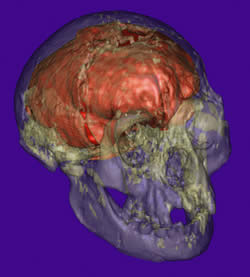Feb 01 2007
The Return of the Hobbit
I reported earlier on the fascinating controversy over the status of Homo floresiensis – dubbed by the media as the Hobbit. Paleontologists are falling into two camps: the first maintains that the fossil (the specimen, which consists of a fairly intact skull about 18,000 years old, was discovered in 2003 on the island of Flores in Indonesia, and is designated Liang Bua 1 or LB1 after the site of its discovery) represents a new hominin species. The second maintains that LB1 represents a pygmy Homo sapiens (fully modern human) who also suffered from a developmental disorder called microcephaly (literally – small head).
The controversy remains without definitive resolution. I had commented that I really enjoy a good scientific controversy – it really showcases the scientific process at its best, but also reveals the messy human side of science. Good stuff. And the Hobbit story is shaping up to be a real epic battle.
In July of 2006 proponents of the microcephaly hypothesis published a fairly devastating paper outlining all the reasons to infer that LB1 is a deformed pygmy human. Some of the major points include the significant facial asymmetry and dental anomalies of LB1 – signs of a developmental disorder. Also, they note that while the average cranial capacity of the modern day Homo sapiens living on Flores is 1,270ml, LB1 has a cranial capacity of about 470ml. This is very small, even when accounting for the overall small stature of LB1. The authors argue that this small brain size is more in line with microcephaly than a hominin species closely related to humans.
Now, in the current issue of the same journal, the Proceedings of he National Academy of Sciences (PNAS), Dean Falk, a paleoneurologist, has published her recent analysis of the shape of the brain of LB1. She and her team made a virtual endocast of the LB1 brain from the fossil skull and compared it to the shape of 9 microcephalic brains and 10 normal human brains. She found that LB1 shared many features in common with normal human brains, but did not share any features with the microcephalic brains. In fact, she characterizes LB1 as having features that are the “antithesis” of microcephaly. In addition, LB1 has features that are unique to it – suggesting that it is a different species.

Falk speculates that H. floresiensis evolved greater intelligence by reorganizing the hardwiring of the brain, rather than evolving a larger brain. So the Hobbit packed more intellectual power per gram of gray matter than do modern humans. This would explain why the fossils were found with an advanced tool kit and clear signs of fire use, despite the small size of the brain.
If Dean Falk is right, then creates a number of fascinating questions: exactly how is H. floresiensis related to H. sapiens; how long did the species survive, how did they stay so isolated for so long on Flores, was there any interbreeding with modern humans, etc.? The most interesting question is one, unfortunately, that we may never answer – how was the brain of H. floresiensis organized for greater efficiency?
The debate is far from over. This type of scientific data can be very compelling, but it is still highly inferential. Opponents will likely search for an alternate interpretation of Falk’s data. And this is a good thing – working out competing ideas is how science progresses. Likely, the debate will not be definitively resolved until more contemporary specimens are found at Liang Bua. Paleontologists have permission to resume their searches there, and hopefully they will find more fossils. There are specimens other than LB1 – but not a single piece of cranium. If further skull specimens are discovered that share features with LB1, that will all but confirm the new species hypothesis and end the controversy. Stay tuned.






